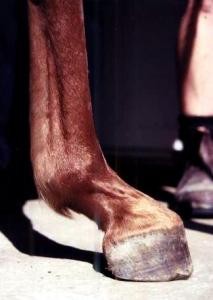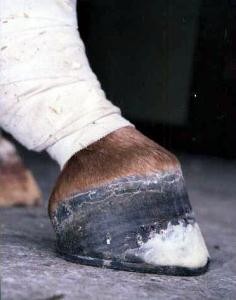Club Foot
This filly was presented to an equine surgeon for assessment at 18 months of age with a severely clubbed right front foot, (broken forward hoof-pastern angle). The foot was short, contracted at the toe, wide at the heels, and unable to be extended into a normal position. Therefore, shoeing alone was unlikely to offer any significant improvement over time, and her foot was likely to cause her lameness problems and severely limit her future potential as a show or riding horse.
The filly was given surgery to cut the check ligament of the deep digital flexor tendon, (inferior check ligament desmotomy). Before discharge from hospital, 3 days post surgery, it was decided to extend the toe of the clubbed foot with a hoof reconstruction material (Equithane), and to fit a graduated-toe shoe to prevent further toe wear and offer protection. At this time, it was noted that an abscess had formed at the toe and the wall was separated. These are common findings in young horses with severely clubbed feet, and further contribute to the abnormal pattern of wear and chronic separation of the white line and dorsal wall (toe).
The filly was initially given hand-walking as exercise, and this was increased to include gentle lunging at the trot by 3 weeks post surgery. This was continued throughout the recovery period of 4 months. During this time the filly had the shoe removed and refitted at 4 weekly intervals. Improvement in the hoof-pastern angle was noted at each shoeing.
It was advised to continue protecting the toe of this foot with either a shoe or tip until at least 6 months post surgery. After this, the foot should be allowed to go unshod if possible, as this will maximise heel function and expansion of the foot while the filly is still growing. Regular trimming at monthly intervals is still required. If the toe should begin to shorten, and the foot becomes more upright, then fitting a shoe or tip will again be required.
When I last saw this filly her owners were considering a riding career for her and her future looked much brighter. However, there is a genetic component to this condition and therefore, I would be unable to predict that this filly would, or would not, produce foals that were at risk of developing the same problem.



Leave a Reply
Want to join the discussion?Feel free to contribute!